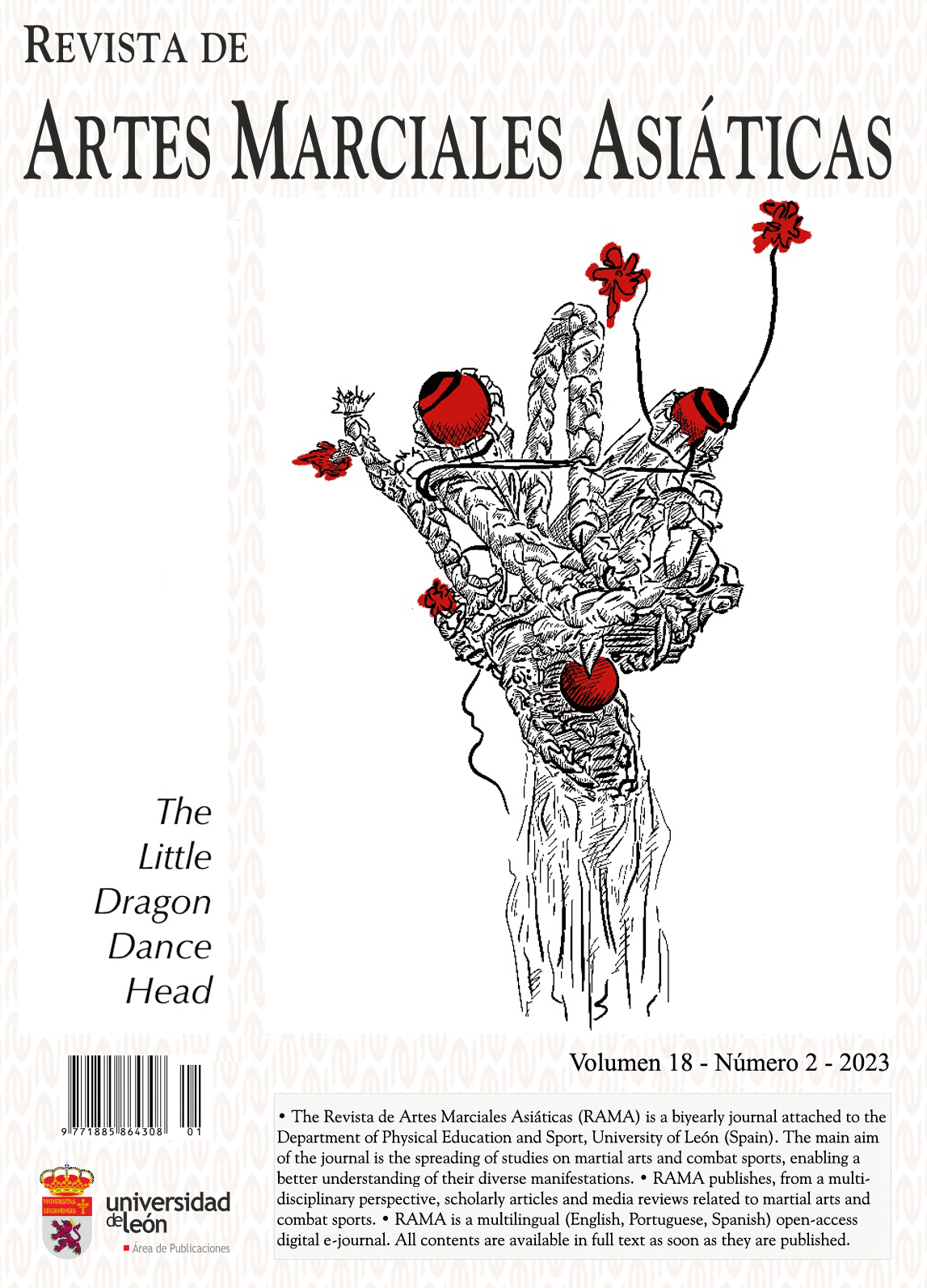Can a fighter develop glass jaw? Statistical evidence from mixed martial arts
DOI:
https://doi.org/10.18002/rama.v18i2.6205Keywords:
Martial arts, combat sports, mixed martial arts, MMA, performance, knockoutAbstract
This paper deals with a phenomenon in combat sports called the glass jaw or glass chin. It is the ability of a fighter to withstand punches to the jaw area without falling unconscious and thus receiving a knockout. The main objective of this paper is to investigate the possibility of developing a glass jaw over the course of a fighter's career, and whether certain fighters are more predisposed to experiencing knockouts. Utilizing data from the largest Mixed Martial Arts organization, the Ultimate Fighting Championship, spanning from 2010 to 2021, statistical models reveal that certain fighters may be more susceptible to knockouts compared to others. Conversely, it could not be shown that the probability of a future knockout loss, that is developing a glass jaw, increased with the number of knockouts received. However, there remains space for a more detailed investigation of this phenomenon. The historically debated resistance training of punches to the head area cannot be recommended. Conversely, it is advisable to observe the fighters' reactions to punches to the head in order to pick out those with a greater predisposition for a knockout. They should then be especially cautious when practicing combat sports.
Downloads
Métricas alternativas
References
Andrade, A., Silva, R. B., & Dominski, F. H. (2020). Application of Sport Psychology in Mixed Martial Arts: A Systematic Review. Kinesiology, 52(01), Article 01.
Bledsoe, G. H., Hsu, E. B., Grabowski, J. G., Brill, J. D., & Li, G. (2006). Incidence of Injury in Professional Mixed Martial Arts Competitions. Journal of Sports Science & Medicine, 5(CSSI), 136–142.
Camilo, J. A. de O., & Spink, M. J. P. (2018). Las Artes Marciales Mixtas (MMA): Deporte, espectáculo y economía. Revista de Artes Marciales Asiáticas, 13(1), 20–34. https://doi.org/10.18002/rama.v13i1.5188
Chen, M. A., & Cheesman, D. J. (2013). Mental Toughness of Mixed Martial Arts Athletes at Different Levels of Competition. Perceptual and Motor Skills, 116(3), 905–917. https://doi.org/10.2466/29.30.PMS.116.3.905-917
Chernozub, A., Korobeynikov, G., Mytskan, B., Korobeinikova, L., & Cynarski, W. J. (2018). Modelling mixed martial arts power training needs depending on the predominance of the strike or wrestling fighting style. Ido Movement for Culture. Journal of Martial Arts Anthropology, 18(3), 28–36. https://doi.org/10.14589/ido.18.3.5
Dabbert, M. (2021). Ultimate UFC Dataset. https://www.kaggle.com/datasets/mdabbert/ultimate-ufc-dataset
Del Vecchio, F. B., Farias, C. B., de Leon, R. C., Rocha, A. C. C. A., Galliano, L. M., & Coswig, V. S. (2018). Injuries in martial arts and combat sports: Prevalence, characteristics and mechanisms. Science & Sports, 33(3), 158–163. https://doi.org/10.1016/j.scispo.2018.02.003
Deng, J. (2023). Race, gender and MMA fandom – imagining Asian masculinities in the online forum of the UFC fan club. Sport in Society, 26(4), 671-686. https://doi.org/10.1080/17430437.2022.2033218
Devlin, M., Billings, A. C., & Leeper, J. (2016). Fighting Fandom: How Fan Identity Influences Self-Reported and Physiological Arousal During Exposure to Violent Sports Imagery. Journal of Sports Media, 11(2), 159–185. https://doi.org/10.1353/jsm.2016.0016
Faro, H., de Lima-Junior, D., & Machado, D. G. da S. (2023). Rapid weight gain predicts fight success in mixed martial arts – evidence from 1,400 weigh-ins. European Journal of Sport Science, 23(1), 8–17. https://doi.org/10.1080/17461391.2021.2013951
Follmer, B., Dellagrana, R. A., & Zehr, E. P. (2019). Head Trauma Exposure in Mixed Martial Arts Varies According to Sex and Weight Class. Sports Health, 11(3), 280–285. https://doi.org/10.1177/1941738119827966
Gift, P. (2018). Performance Evaluation and Favoritism: Evidence From Mixed Martial Arts. Journal of Sports Economics, 19(8), 1147–1173. https://doi.org/10.1177/1527002517702422
Gift, P. (2020). Moving the Needle in MMA: On the Marginal Revenue Product of UFC Fighters. Journal of Sports Economics, 21(2), 176–209. https://doi.org/10.1177/1527002519885432
Giza, C. C., & Hovda, D. A. (2014). The New Neurometabolic Cascade of Concussion. Neurosurgery, 75, S24. https://doi.org/10.1227/NEU.0000000000000505
Hammami, N., Hattabi, S., Salhi, A., Rezgui, T., Oueslati, M., & Bouassida, A. (2018). Combat sport injuries profile: A review. Science & Sports, 33(2), 73–79. https://doi.org/10.1016/j.scispo.2017.04.014
Hånell, A., & Rostami, E. (2020). How Can a Punch Knock You Out? Frontiers in Neurology, 11. https://www.frontiersin.org/articles/10.3389/fneur.2020.570566
Hirose, A., & Pih, K. K. (2010). Men Who Strike and Men Who Submit: Hegemonic and Marginalized Masculinities in Mixed Martial Arts. Men and Masculinities, 13(2), 190–209. https://doi.org/10.1177/1097184X09344417
Jang, S. H., Kim, O. L., Kim, S. H., & Kim, J. B. (2019). The Relation Between Loss of Consciousness, Severity of Traumatic Brain Injury, and Injury of Ascending Reticular Activating System in Patients With Traumatic Brain Injury. American Journal of Physical Medicine & Rehabilitation, 98(12), 1067–1071. https://doi.org/10.1097/PHM.0000000000001243
Jensen, A. R., Maciel, R. C., Petrigliano, F. A., Rodriguez, J. P., & Brooks, A. G. (2017). Injuries Sustained by the Mixed Martial Arts Athlete. Sports Health, 9(1), 64–69. https://doi.org/10.1177/1941738116664860
Kaplan, H. A., & Browder, J. (1954). Observations on the Clinical and Brain Wave Patterns of Professional Boxers. Journal of the American Medical Association, 156(12), 1138–1144. https://doi.org/10.1001/jama.1954.02950120012004
Karpman, S., Reid, P., Phillips, L., Qin, Z., & Gross, D. P. (2016). Combative Sports Injuries: An Edmonton Retrospective. Clinical Journal of Sport Medicine, 26(4), 332–334. https://doi.org/10.1097/JSM.0000000000000235
Kesting, S. (2015, September 12). Does MMA Make You Stupid? Impact, Concussions and Brain Damage in Mixed Martial Arts. Grapplearts. https://www.grapplearts.com/does-mma-make-you-stupid-impact-concussions-and-brain-damage-in-mixed-martial-arts/
Kirkwood, M., Yap, S.-F., & Xu, Y. (2019). An Exploration of Sport Fandom in Online Communities. International Journal of Sport Communication, 12(1), 55–78. https://doi.org/10.1123/ijsc.2018-0133
Lota, K. S., Malliaropoulos, N., Blach, W., Kamitani, T., Ikumi, A., Korakakis, V., & Maffulli, N. (2022). Rotational head acceleration and traumatic brain injury in combat sports: A systematic review. British Medical Bulletin, 141(1), 33–46. https://doi.org/10.1093/bmb/ldac002
Lystad, R. P., Gregory, K., & Wilson, J. (2014). The Epidemiology of Injuries in Mixed Martial Arts: A Systematic Review and Meta-analysis. Orthopaedic Journal of Sports Medicine, 2(1), 2325967113518492. https://doi.org/10.1177/2325967113518492
Massey, W. V., Meyer, B. B., & Naylor, A. H. (2013). Toward a grounded theory of self-regulation in mixed martial arts. Psychology of Sport and Exercise, 14(1), 12–20. https://doi.org/10.1016/j.psychsport.2012.06.008
Miarka, B., Brito, C. J., & Amtmann, J. (2017). Performance probabilities and outcome effects in technical–tactical factors with bout phase changes of mixed martial arts. International Journal of Performance Analysis in Sport, 17(4), 510–520. https://doi.org/10.1080/24748668.2017.1360103
Mickelsson, T. B., & Shaw, V. (2020). Performance increments without audience: Paired data from mixed martial arts fighters during COVID-19. Revista de Artes Marciales Asiáticas, 15(2), Article 2. https://doi.org/10.18002/rama.v15i2.6294
Mierzwinski, M., Velija, P., & Malcolm, D. (2014). Women’s Experiences in the Mixed Martial Arts: A Quest for Excitement? Sociology of Sport Journal, 31(1), 66–84. https://doi.org/10.1123/ssj.2013-0125
Seifert, T., & Shipman, V. (2015). The Pathophysiology of Sports Concussion. Current Pain and Headache Reports, 19(8), 36. https://doi.org/10.1007/s11916-015-0513-0
Seungmo, K., Greenwell, T. C., Andrew, D. P. S., Lee, J., & Mahony, D. F. (2008). An Analysis of Spectator Motives in an Individual Combat Sport: A Study of Mixed Martial Arts Fans. Sport Marketing Quarterly, 17, 109–119.
UFC.com. (2022). The Official Home of Ultimate Fighting Championship | UFC.com. https://www.ufc.com/
Vaccaro, C. A., Schrock, D. P., & McCabe, J. M. (2011). Managing Emotional Manhood: Fighting and Fostering Fear in Mixed Martial Arts. Social Psychology Quarterly, 74(4), 414–437. https://doi.org/10.1177/0190272511415554
Warrier, R. (2021). UFC-Fight historical data from 1993 to 2021. Kaggle. https://www.kaggle.com/datasets/rajeevw/ufcdata
Downloads
Published
How to Cite
Issue
Section
License
Copyright (c) 2023 Vojtech Kotrba

This work is licensed under a Creative Commons Attribution-NonCommercial-ShareAlike 4.0 International License.
The authors who publish in this journal must agree to the following terms:
- The authors grant on a nonexclusive basis the exploitation rights (reproduction, distribution, public communication and transformation) of the work accepted for publication to the University of León. The authors can establish, on their own, additional agreements for the non-exclusive distribution of the version of the work published in the journal (for example, placing it in an institutional repository or publishing it in a book), always acknowledging the initial publication in this journal.
- This work is licensed under the Creative Commons Attribution-NonCommercial-ShareAlike 4.0 International License. Click to see basic information and the legal text of the license.
- The authors are allowed and encouraged to disseminate electronically pre-print or post-print versions of their work before publication, as this can give rise to productive exchanges, as well as earlier and increased citing of the works published.











